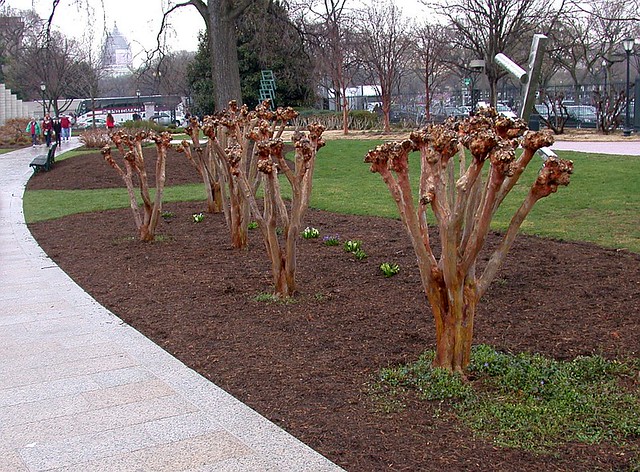
Pollarded crape myrtles, National Gallery of Art Sculpture Garden
It's that time of year again, when southern homeowners and landscape crews look at crape myrtles (Lagerstroemia species and cultivars) with murder in their hearts. "Crape murder", as the brutal pruning of crape myrtles is often dubbed, is also becoming depressingly common here in Washington, DC with many mature, beautiful specimens being hacked to bits. Who on earth thinks this looks good? Who on earth thinks this is the right thing to do? Enough "professionals" do this that my biggest question is, who on earth is TRAINING people to do this?
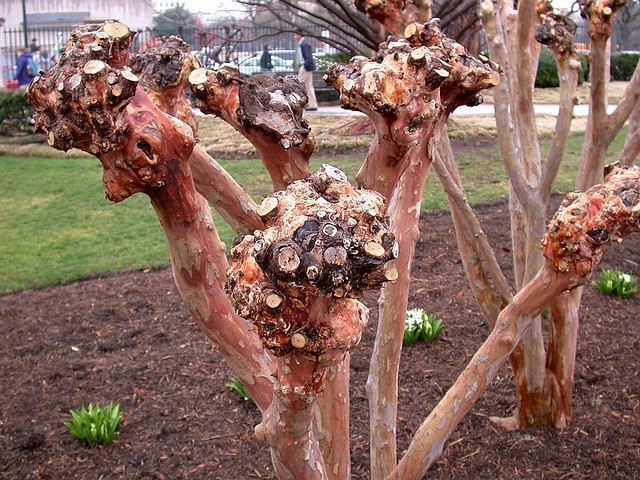
Closeup
But... is it murder, or is it something else? I posted the above photos, taken in the National Gallery of Art Sculpture Garden about a week ago, in a gardening group on Facebook and it provoked quite a reaction. About 75% considered it "murder", about 20% considered it "pollarding" (without necessarily liking it), and about 5% liked the effect and actually approved of the practice.
Pollarding is an ancient horticultural practice of annually cutting back a tree or shrub's branches, forcing the production of long, rapidly-growing, whip-like branches. The cut ends eventually form large, knobby stumps. It was once done for primarily utilitarian reasons: production of livestock fodder or wood for fuel or other purposes. In the modern landscape it's a matter of style, and of personal taste. It's not a look I care for; I think the natural form of a crape myrtle is graceful and beautiful, and best left alone.

Lagerstroemia 'Lipan', never pruned. National Arboretum, July 2010
Crape myrtles require minimal pruning and provide year-round interest. In addition to their summer flowers, they have attractively contorted trunks and branches, ornamental bark, and good fall color. Whether you call it pollarding or crape murder, it turns a tough, low-maintenance landscape plant into something that requires regular maintenance. Lazy gardener that I am, the thought of creating unnecessary work for myself makes me shudder.

Lagerstroemia 'Zuni', National Arboretum, July 2010
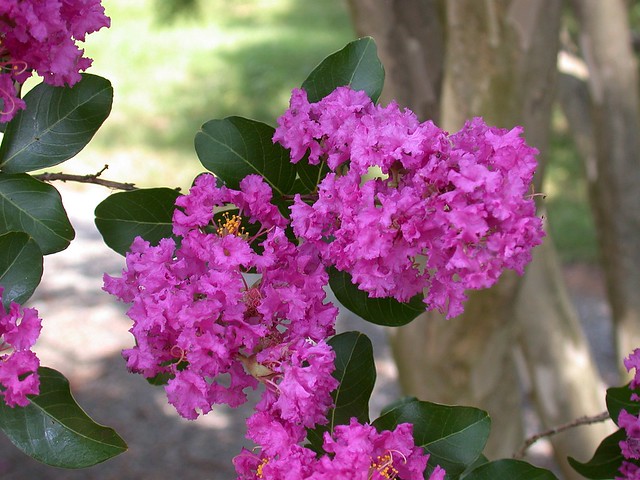
Lagerstroemia 'Zuni', flowers
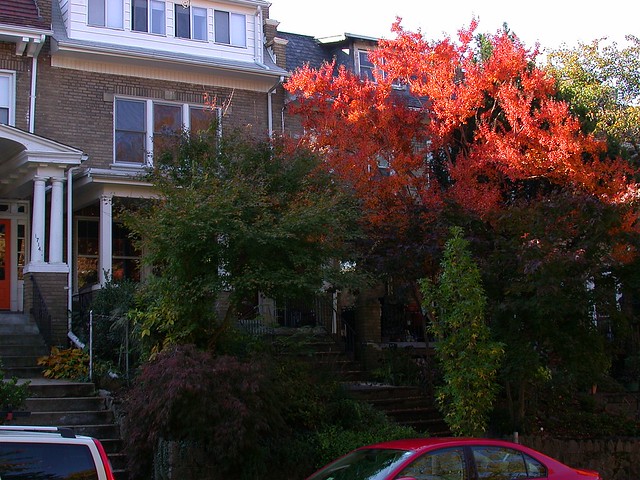
Crape myrtle fall color
The specimens in the Sculpture Garden are pollarded. It's clearly intentional, for a particular desired effect, and done annually by horticultural professionals who know what they're doing. I reserve "crape murder" for something else. When I see a large, beautiful, mature, and natural-looking specimen cut back to fat, ugly stumps of large branches for no apparent reason--what most of us would call "topping" on any other tree--that's murder.

This is murder. Washington, DC; May 2014
I suspect most people doing this wouldn't know the word "pollard" if it bit them on the ass. I have no idea why they're doing it, and I don't think they do either. Perhaps they simply see everybody else doing it and think it's the right thing to do, even "necessary" (which is most certainly is not!). They are then left untouched for several more years, but the damage has been done. This was a very uncommon practice in Washington, DC when I moved here 24 years ago, but in recent years I've been sad to see more and more beautiful old specimens suffer this fate.

Mature crape myrtles in Washington, DC
Pollarding is a matter of taste, and who am I to judge? (Well, I will, but in most cases silently.) I'll give you grudging permission to do it to your crape myrtles if (a) you know what the word "pollarding" means, (b) you can explain why you're doing it, and (c) you do it each and every year, without fail. But if you skip just one year, I'm calling the horticultural cops to report a murder.
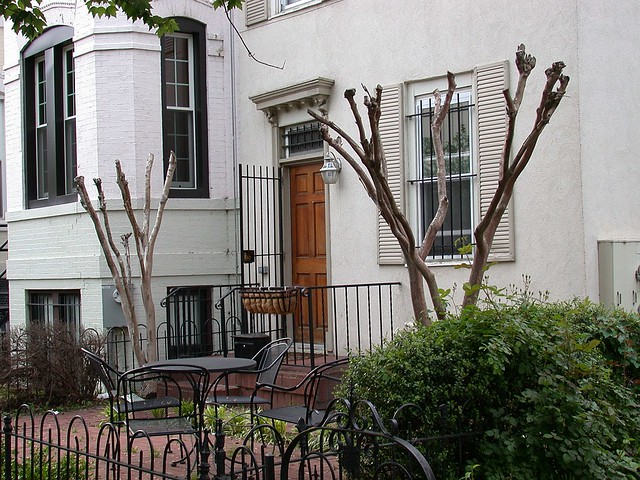
Pollarding or murder? Tough call. Washington, DC; May 2014
So... what are your thoughts on pollarding crape myrtles? Is it ever acceptable, or is it always "crape murder"?
Recent articles on crape murder:
How to avoid hacking at your crape myrtle this spring (Adrian Higgins, Washington Post)
How to fix crape murder (Steve Bender, a.k.a. Grumpy Gardener)

Very English garden thing to do, quite common here on traditional gardens and properties but not on crape myrtles. It's an acquired taste, personally I'm not keen on it but at least the plants treated as such are still alive.
ReplyDeleteSo many reasons I feel for this practice:
ReplyDelete1) poor choice of tree, not realizing what the 5 year size will be - I think this is the #1 reason, myself
2) new homeowner desiring more light in a window
3) simply custom - i.e. everyone does it, so I must do it to mine
4) desiring a highly manicured look on all their landscaping. I feel like this is a particularly Southern custom - the prejudice against a natural (i.e. 'wild') look is very strong here. A wild look is seen as a sign of laziness by the landowner. Excessively taming nature is ingrained in our psyche.
The custom thing is powerful - the highway department here in Arkansas does it to all the crape myrtles along our central freeway. Those plants are sited such that they have MORE than enough room to reach their natural size but since the majority of crape myrtles are hacked like that, it *must* be the right thing to do.
Pollarding seems to be on the rise here in the wild west where we used to leave trees alone. Maybe because many of our landscape crews are now coming from other parts of the world. Crape myrtles are not common here as we don't get the summer heat that they love so they're safe but I just saw some lovely white birches topped by half. We'll see if they continue to butcher them every year. I don't like the practice but understand that in Europe it is done to street trees because allowing them to reach mature size would not be a good thing. Here's an idea, plant trees that mature at a smaller size!
ReplyDeleteI do think it's a shame to torture trees in this way, when they would be so beautiful left on their own. Those knobs are so ugly.
ReplyDeleteThere are more and more Crape Myrtles showing up in Portland, as people are realizing they're beautiful trees and some are well adapted to our climate. I think because they're so prized by those who plant them, and not at all common, they've escaped this treatment. However there are plenty of other trees who are not so lucky. There are a pair of houses on my block that have pollarded their trees to within an inch of their lives. In these cases it's all about the need to exert control over mother nature.
ReplyDeletePollarding is grotesque. I've seen pollarded trees in Paris and it just seems so brutal. The trees were less a living thing and more of a large green object sculpted to architectural specs. It reminds me of horticultural foot binding. But crepe murder is just plain herd mentality ignorance on display.
ReplyDeleteIt seems like the farther south you go the more common this practice is. I have barely seen it on Crape myrtles here. I have seen some pruned into shrub shape which is pretty weird but most of those are still young so the pruning is not severe yet. I'm pretty against pruning that severely. It seems like it's really common to see when crapes are growing in way too small of a spot. There are so many dwarf growing crapes out there now I wonder why people who want low growing crapes don't try looking for those instead.
ReplyDeleteThanks for sharing. Those untouched crapes are beautiful!
I really dislike pollarding. Crepe Myrtles are a common tree in Sydney gardens and it used to be the done thing. Also, like the Parisians, our London Plane street trees were once pollarded, but thanks to ever diminishing council budgets that hasn't been done for at least 50 years, so thankfully, the whole practice has fallen out of fashion. It is devastating for a tree that has been pollarded to be allowed to regrow, as those whippy branches ultimately fail and come crashing down.
ReplyDeleteIt beggars belief, especially when the natural form is so stunning and manicured: the shape reminds me of the old American Elms
don't come to argentina then! people do this everywhere in the cities, so trees don't interfere with the power lines. But actually is the power lines that interfere with the trees! (I hate it, I almost denounce the electric service guys when they pollarded the old Erythrina falcata of my house entrance)
ReplyDeleteSorry for my English!
I have never understood how anyone thinks this is attractive. It's ugly when the tree is chopped off and just plain weird when all those spindly branches sprout off the "fat" bases. Ugh!!
ReplyDelete